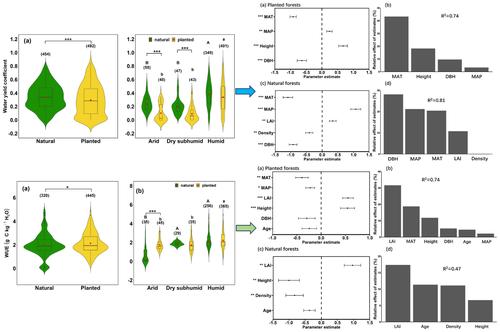当前位置:
X-MOL 学术
›
Glob. Change Biol.
›
论文详情
Our official English website, www.x-mol.net, welcomes your
feedback! (Note: you will need to create a separate account there.)
Balancing Water Yield and Water Use Efficiency Between Planted and Natural Forests: A Global Analysis
Global Change Biology ( IF 10.8 ) Pub Date : 2024-11-02 , DOI: 10.1111/gcb.17561 Shulan Sun, Wenhua Xiang, Shuai Ouyang, Yanting Hu, Changhui Peng
Global Change Biology ( IF 10.8 ) Pub Date : 2024-11-02 , DOI: 10.1111/gcb.17561 Shulan Sun, Wenhua Xiang, Shuai Ouyang, Yanting Hu, Changhui Peng

|
Climate warming is projected to affect hydrological cycle in forest ecosystems and makes the forest–water relationship more controversial. Currently, planted forests are gaining more public attention due to their role in carbon sequestration and wood production relative to natural forests. However, little is known about how the global patterns and drivers of water yield and water‐use efficiency (WUE) differ between planted and natural forests. Here, we conduct a global analysis to compare water yield and WUE in planted and natural forests using 946 observations from 112 published studies. The results showed that global average water yield coefficient was 0.29 for planted forests and 0.34 for natural forests. Planted forests exhibited lower water yield coefficient (p < 0.05) in three climatic regions (arid, dry subhumid, and humid regions), but higher (p < 0.01) WUE only in arid region, compared with natural forests. Both water yield coefficient and WUE in planted forests were significantly lower (p < 0.05) than that in natural forests for stand characteristic groups (stand density, average tree height, leaf area index [LAI], and basal area). Additionally, stand density within the ranging between 1000 to 2000 stem ha−1 can maximize the water yield and WUE in planted and natural forests. Water yield coefficient in planted forests was primarily controlled by the factors related to tree growth (i.e., tree height, DBH), while that of natural forest mainly affected by stand structure (i.e., LAI, stand density, DBH). WUE in planted forest was more sensitive to climate than in natural forests. This work highlights the critical role of natural forests in water supply and the importance of tree species selection and stand management (e.g., stand density adjustment) in plantations in future forest restoration policies and climate change mitigation.
中文翻译:

平衡人工林和天然林之间的产水和用水效率:全球分析
预计气候变暖会影响森林生态系统中的水文循环,并使森林-水关系更具争议性。目前,人工林相对于天然林在碳封存和木材生产中的作用,因此受到公众的更多关注。然而,对于人工林和天然林之间产水量和用水效率 (WUE) 的全球模式和驱动因素有何不同,人们知之甚少。在这里,我们进行了一项全球分析,使用来自 112 项已发表研究的 946 次观察来比较人工林和天然林的产水和 WUE。结果表明,人工林的全球平均产水系数为 0.29,天然林为 0.34。与天然林相比,人工林在三个气候区(干旱、干燥半湿润和湿润地区)的产水系数较低 (p < 0.05),但仅在干旱地区表现出较高的 (p < 0.01) WUE。对于林分特征组(林分密度、平均树高、叶面积指数 [LAI] 和基部面积),人工林的产水系数和 WUE 均显著低于天然林 (p < 0.05)。此外,1000 至 2000 茎 ha-1 范围内的林分密度可以最大限度地提高人工林和天然林的产水和 WUE。人工林的产水系数主要受树木生长相关因素(树高、胸径)的控制,而天然林的产水系数主要受林分结构(林分密度、林分密度、胸径)的影响。人工林的 WUE 比天然林对气候更敏感。这项工作强调了天然林在供水中的关键作用以及树种选择和林分管理的重要性(例如,林分密度调整)在未来森林恢复政策和气候变化缓解中。
更新日期:2024-11-02
中文翻译:

平衡人工林和天然林之间的产水和用水效率:全球分析
预计气候变暖会影响森林生态系统中的水文循环,并使森林-水关系更具争议性。目前,人工林相对于天然林在碳封存和木材生产中的作用,因此受到公众的更多关注。然而,对于人工林和天然林之间产水量和用水效率 (WUE) 的全球模式和驱动因素有何不同,人们知之甚少。在这里,我们进行了一项全球分析,使用来自 112 项已发表研究的 946 次观察来比较人工林和天然林的产水和 WUE。结果表明,人工林的全球平均产水系数为 0.29,天然林为 0.34。与天然林相比,人工林在三个气候区(干旱、干燥半湿润和湿润地区)的产水系数较低 (p < 0.05),但仅在干旱地区表现出较高的 (p < 0.01) WUE。对于林分特征组(林分密度、平均树高、叶面积指数 [LAI] 和基部面积),人工林的产水系数和 WUE 均显著低于天然林 (p < 0.05)。此外,1000 至 2000 茎 ha-1 范围内的林分密度可以最大限度地提高人工林和天然林的产水和 WUE。人工林的产水系数主要受树木生长相关因素(树高、胸径)的控制,而天然林的产水系数主要受林分结构(林分密度、林分密度、胸径)的影响。人工林的 WUE 比天然林对气候更敏感。这项工作强调了天然林在供水中的关键作用以及树种选择和林分管理的重要性(例如,林分密度调整)在未来森林恢复政策和气候变化缓解中。


















































 京公网安备 11010802027423号
京公网安备 11010802027423号